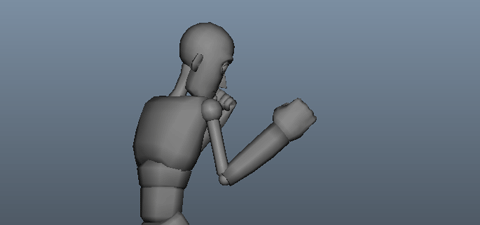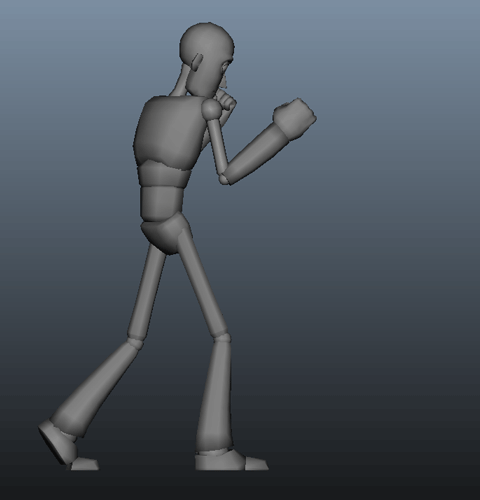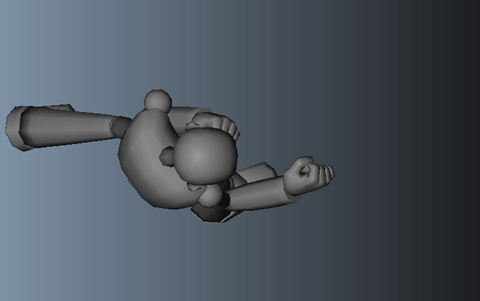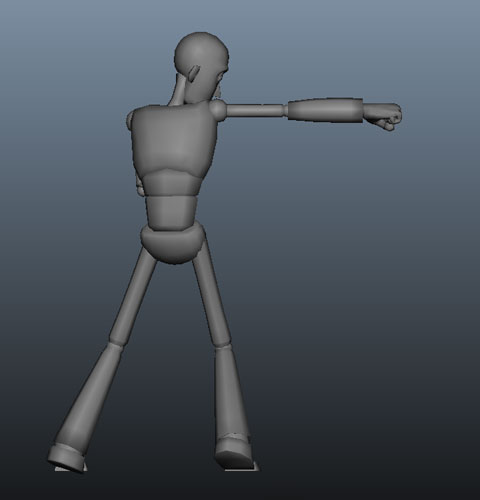In Part 2, I showed the little diagrams I’ve been using to clarify in my own mind the components of striking, and I wrote a bit about relationship between the Base and the Center of Mass (COM). I’m going to keep moving up towards the point of impact and talk about how to move the COM.
COM
In animation, I believe you should always move from simple to complex; and I think that also holds true for martial arts. In talking about moving the COM in punching, I’m going to stick to a stationary arrangement with the Base.
The Feeder, the one attacking, doesn’t thrust his whole COM forward when punching. That could break his base and, in this case, we’re trying to stay stationary. Instead, to generate power for his punch, the Feeder rotates his COM. You can think of the movement being like the pistons and crankshaft in a car.

To rotate the COM without injury, let’s back up and address the Base again. If you were to try turning your hips to face a different direction while keeping your heels planted on the ground (please, don’t actually do this) you’d blow your knees out. You can only go so far before the structure of your knees and ankle joints stop the movement. If you go farther, you get a trip to the Orthopedic Surgeon.
This is one of those cases where what’s important in real life is also important in animation. In real life, you get injured. In animation, you get a movement that looks weird or broken. The audience may not know why it looks that way, but they’ll feel it for sure.
The good news is, the solution is easy: pick up your heels. The Feeder needs to pivot on the balls of his feet, so his feet and knees stay in line with his hips. No knee surgery and no broken animated characters.


So which comes first? Does the COM rotate because the feet pivot? Or do the feet pivot because the COM rotated? It’s a chicken and the egg question so whatever works for you. Do you think more in Forward Kinematics (the feet turn and the COM is resting on the feet therefore it turns) or Inverse Kinematics (the COM turns and pulls the feet along with it)? For purposes of readable animation by the audience, you may want to break it up: the foot starts turning, one frame later the hip starts turning, and so on up the FK chain. But we’ll get into that animation vs. reality adjustment later.
Structure
In martial arts, structure can refer to a lot of things. In can be body alignment from your shoulder to your fist, or within your torso, or from the ground all the way to the point of impact. For the purpose of teaching striking fundamentals to Animators, when I say Structure I’m talking primarily about the structure transferring the rotational energy of the COM to the Connection (point of impact).
The strongest Structure when you’re talking about boxing is going to be a straight line. For straight punches like the Jab (lead hand punch) or the Cross (rear hand punch) the Feeder should be able to draw a straight line from his hand though his wrist and elbow, and into his COM.

This is another case where reality and animation overlap because that nice straight Structure is going to be a stronger pose than a crooked one. It seems obvious, but I’ve seen some egregious examples of ignoring that idea among both Martial Artists and Animators. I’ll get into more complicated interpretations of this Structure for Jabs, Hooks, Overhands, and Chung Chuie (close range punching from Wing Chun) in a later installment.
Connection
I was fortunate enough to study a little Ten Shin Ichi Ryu with Soshu Shiro Shintaku. He always talked about “making harmonious contact” in grappling and striking techniques. When you lock or throw an opponent, you make connection, then turn your body to throw them. You don’t just yank on the person with your arms. You’re expressing a movement with COM and the Connection is just there to transmit that movment.
There’s really nothing more to that concept. In a later post, I’ll get into differences between styles when in comes to striking with the hands like: horizontal vs. vertical fist, finger jabs, palm strikes, and so on.
Hopefully, you noticed that I spent progressively less time explaining as I moved from the ground up to the point of contact. That should tell you something. If you’re talking about the mechanics of punching, the most important thing isn’t the fist! In martial arts, I see a lot of people putting all the emphasis on the target or what they’re doing with their hands, and completely ignoring their Base. In animation, I see a lot of people concentrating on flowery, dramatic movement with the arms and legs, but paying no attention to the COM.